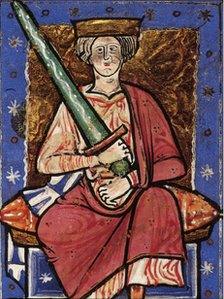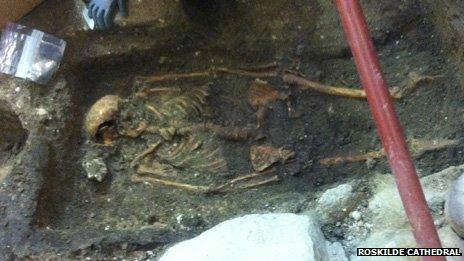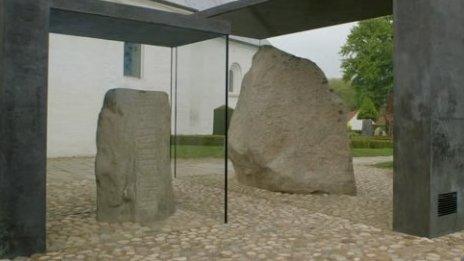Sweyn Forkbeard: England's forgotten Viking king
- Published

Sweyn Forkbeard (shown left), England's shortest reigning king, remains in the shadows of both his son Canute the Great, and father Harold Bluetooth
On Christmas Day 1013, Danish ruler Sweyn Forkbeard was declared King of all England and the town of Gainsborough its capital. But why is so little known of the man who would be England's shortest-reigning king and the role he played in shaping the early history of the nation?
For 20 years, Sweyn, a "murderous character" who deposed his father Harold Bluetooth, waged war on England.
And exactly 1,000 years ago, with his son Canute by his side, a large-scale invasion finally proved decisive.
It was a brutal time, which saw women burned alive, children impaled on lances and men dying suspended from their private parts.

King Ethelred ordered an "extermination" of England's Danes
Gainsborough historian Darron Childs says: "It is perhaps one of the reasons why Sweyn has been largely forgotten.
"It's hard to make a big thing of someone so bad - it would be a bit like celebrating Hitler. It's a difficult thing to try and overcome."
However, he adds: "He was part of a dynasty that changed the course of this country.
"And he wasn't any different to many of his contemporaries. People like Ethelred, who were equally as bad - if not worse."
Ethelred the Unready had ordered the slaughter of all Danes living in England in 1002, in what became known as the St Brice's Day massacre.
Another reason why Sweyn's story remains largely untold may be the lack of physical evidence.
Mr Childs says there was once a fortification in Gainsborough on the site of what is now the Old Hall, with evidence of a moat fed from the nearby River Trent.
And clues to a "sizeable" army camp can also be found in the town's Castle Hills.

Sweyn Forkbeard made what is now the Old Hall in Gainsborough the centre of his operations but ruled for just 40 days

Catherine Howard (portrayed here by Bryony Roberts) and Richard III are among royal figures who stayed at the medieval building between 1460 and 1480

Alfred the Great married Elswitha in Gainsborough - she was the daughter of a local nobleman

One of the few reminders of Gainsborough's Viking heritage is The Sweyn Forkbeard pub

Another is a blue plaque marking the site of an old Danish chapel on the banks of the River Trent

Gainsborough is reputed to be the UK's most inland port and has had a long history of river shipping
He also believes the Lincolnshire town could have been where Sweyn's son, Canute, attempted to hold back the waves of the Aegir - a tidal bore, which takes its name from the Viking God of the Sea. But there is little, if any, physical proof.
Despite this, Mr Childs says Gainsborough was a very important place (Alfred the Great, for example, was married there in 868) and he believes more should be done to mark Sweyn's time in the town.
Mr Childs is one of a growing number of people campaigning for a tourist trail, or festival, to recognise Viking history in Gainsborough.
Earlier this year, the annual riverside festival had a Viking theme and some local schools ran Sweyn Forkbeard projects.
But Mr Childs says there is still a lot more that could be done.
"In Denmark, they have places to visit where a Viking community is recreated - that would be fantastic if we could have that here.
"York has festivals - the Vikings colonised York and made it their main base during the first waves but there is a missing link here - a story which deserves to be told."
He adds that many local people were direct descendants of the Vikings - the majority of Gainsborough's households listed in the Domesday Book were occupied by Danes.

In October, as part of the Illuminating York Festival, images telling the story of Harold Bluetooth, Sweyn and Canute were projected on Clifford's Tower
However, it was perhaps the willingness of Sweyn's son Canute to embrace Christianity - unlike Sweyn himself - that influenced his place in the history books.
"This was a big change," Mr Childs explains. "If he becomes a Christian he abandons a lot of the Viking traditions - but this would make him more acceptable to the people."
"By 1018 he [Canute] had become the most powerful ruler of his age - King of England, Denmark and Norway, earning him the title of the Great."

Canute accepted there were higher powers than him after his failed attempt to hold back the tide
It is a theory supported by Chris Tuckley, head of interpretation for York Archaeological Trust.
He says: "Sweyn is unjustly neglected, given his impact on English history for two decades, and his lasting legacy.
"This must be in part down to his reputation amongst English medieval chroniclers who are pretty unequivocal in painting him as an out-and-out villain."
"They were generally more kindly disposed to his son."
Mr Tuckley says Sweyn's "destruction and plunder was on a scale not to be repeated until the years of the Norman Conquest, half a century later".
"He remains a figure of Viking excess, presiding over a campaign of robbery and casual cruelty, the accounts of which still have the power to shock."
In his native Denmark, he is not held in the same regard as other members of the royal family.
David Høyer, of Roskilde Cathedral, where Sweyn's remains are thought to have been taken, says: "Sweyn is no doubt overshadowed by his father Harold Bluetooth, who is considered the father of the Danes, and his son, Canute, the Great.
The lack of a body, or grave, is perhaps another reason why he remains in the shadows of Canute - whose remains are in Winchester Cathedral.
Even in death, Sweyn still leaves many questions unanswered, including who killed him just 40 days after his accession.
One popular theory is he was murdered by the ghost of St Edmund, who was himself killed by Sweyn's Viking predecessors.
It is said that he returned from the grave in the dead of night during Candlemass and took his revenge with a spear.
However, Mr Childs suggests the story may have been a cover up.
"Sweyn was ruthless and a lot of questions remain about who he may have upset at the time - was there someone within his court ready to stick the knife in?"
He added: "All we do know is he goes down in history as the nation's shortest reigning monarch."
Archaeologists have recently discovered human remains at Roskilde Cathedral on the site of an old wooden church, built by Harold Bluetooth.
It is unknown at this stage who the remains belong to.

There has been speculation that an unidentified skeleton recently found in the grounds of Roskilde Cathedral could be Sweyn or Harold Bluetooth

The cathedral has been the mausoleum of the Danish royal family since the 15th Century

Harold Bluetooth had the Jelling Monument built in 970 to mark Denmark's conversion to Christianity
So, as with Richard III - discovered under a council car park in Leicester - it seems if Sweyn's remains were to be found his story might once again be told.
Until then, a pub bearing his name is the only obvious sign of his time in Gainsborough and its short-lived role as capital of England.
- Published9 February 2013
- Published26 September 2013
- Published3 April 2012